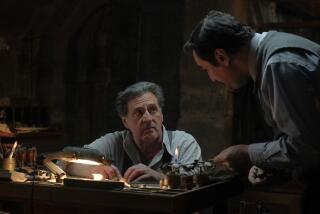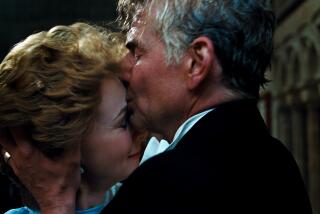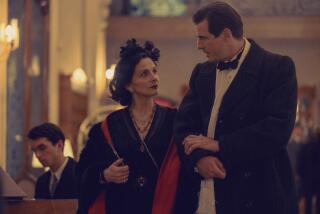The 13 faces of Cate Blanchett: How ‘Manifesto’ went from art installation to film
Some might think that listening to artistic manifestoes — statements of principles and calls to action — is akin to a tortuous graduate lecture in art history.
But in the hands of two-time Oscar-winning actress Cate Blanchett and German video artist Julian Rosefeldt, the highbrow language becomes something else entirely. Together, Blanchett and Rosefeldt bring humor, emotion and poetry to “Manifesto,” a 13-screen video installation-turned-film.
Their unlikely collaboration was sparked in 2010 when Blanchett was introduced to Rosefeldt at the opening of an exhibition of the German video artist’s work in Berlin.
“I loved how at once theatrical and how diverse his work is — how physical it is,” Blanchett says.
Two years later, they joined to create the video installation, in which Blanchett takes on 13 personas — ranging from a scruffy homeless man to a tattooed punk rocker to a puppet maker — while reciting portions of manifestoes from more than 60 20th century artists, including Lars von Trier, Yvonne Rainer, Jim Jarmusch, Sol LeWitt, André Breton and Werner Herzog.
Each 10½-minute vignette of Blanchett in the different artist roles plays simultaneously on separate screens. The segments end with the individual characters speaking at varying pitches in a rapid monotone that, brought together, create a symphonic jumble of accents, sights and sounds.

Watch Cate Blanchett in an exclusive clip from “Manifesto.” Warning: some adult language.
“Julian’s conception was to put the texts in dialogue with one another in the multi-channel work so you end up finding intense points of connection and similarity with all these assertions of artistic uniqueness and individuality,” Blanchett says by phone after a screening of the film version of the work at the Tribeca Film Festival. The movie opens Friday in Los Angeles.
“Cate and I were just basically interested in experimenting with this installation,” says Rosefeldt, whose work is part of the permanent collection at the Museum of Modern Art in New York, the Saatchi Gallery in London and Germany’s Kunstmuseum. “The reason for the film version was a very functional one in the beginning: We needed to finance the installation, so we needed to get some people on board.”
As it happened, Bavarian Broadcasting BR in Germany was launching a new show in which artists were invited to do a project on TV. The company agreed to contribute to “Manifesto,” but Rosefeldt needed to create a linear version for broadcast. “So I was kind of forced to do the film,” he says, laughing. “But now I’m very, very happy that that happened.”
Often we only had one take, so it was kind of a bit like theatrical standup.
— Cate Blanchett
Translating the video installation into a 95-minute movie proved to be a challenge.
“We thought it would be very easy, but we essentially had to start again from scratch,” Rosefeldt says. “It was about creating — due to the absence of a real story — a visual story that would guide you through the film.”
The idea for “Manifesto” came to the artist while researching a separate project on feminist theory. He came across a text on futurism by poet and choreographer Valentine de Saint-Point, which led him to seek out more manifestoes on film and in theater, dance and architecture. Eventually, he would take snippets of those writings, melding and re-imagining them as a unified work of art.
Once he narrowed his material, Rosefeldt presented Blanchett a list of 50 to 60 scenarios and an equal number of character types. The two spent a day together in New York, talking about ways to connect characters with scenarios.
“Some of the manifestoes lend themselves more to conversations, and some took place much more as an inner voice, more like an inner monologue,” Blanchett says.
They then were joined by makeup artist Morag Ross, hairstylist Massimo Gattabrusi and costume designer Bina Daigeler to work out what each character would look like.
“It was a genuine collaboration,” Blanchett says.
It also was a bit of a family affair. Blanchett’s playwright-director husband, Andrew Upton, and three of their four children appear in a vignette in which she plays a conservative mother, sitting down for a meal with her family while reciting artist Claes Oldenburg’s 1961 “I Am for an Art…” manifesto.
‘Manifesto’ was shot in Berlin in just 12 days — 11 with Blanchett. ‘I would say we worked on the output level of a very bad telenovela.’
— Julian Rosefeldt, video artist
“I was a bit snookered by Julian. A couple days before we filmed that, Julian said, ‘Look, how would you feel about your family being in that scene?’ ” the actress says. “I asked them — because obviously we do try to quarantine the kids from that sort of exposure. But the kids were fantastic — they loved it.”
“Manifesto” was shot in Berlin in just 12 days — 11 with Blanchett. “I would say we worked on the output level of a very bad telenovela,” Rosefeldt says, laughing.
The tight schedule meant the actress would have little time to shape and invent the characters, accents and movements. “Often, we only had one take, so it was kind of a bit like theatrical standup, in a way,” she says. “It was either going to work or not work.”
Rosefeldt, who has a background in architecture, selected several architecturally significant sites as settings, though he intentionally made the locations only partially recognizable. “I think if you look for something that is not easy to be identified and action happens there,” he says, “then you as a viewer are much more engaged.”
Though “Manifesto” was conceived as a work of art, Rosefeldt says, the audience for the film is anyone who walks into a movie theater or museum. “If you don’t have the privilege to receive a certain kind of education, you would not get the idea to go in a museum on a Sunday afternoon,” he says. “One of the dilemmas of contemporary art in general is that we are pretending to address our issues to everybody, but we actually address them to a very privileged minority.”
One of the dilemmas of contemporary art...is that we...pretend...to address our issues to everybody, but we actually address them to a...privileged minority.
— Julian Rosefeldt, video artist
Movies, however, are different. “You might mistakenly end up seeing ‘Manifesto’ because you confuse it with the name of an action film,” Rosefeldt says. “I think a lot about that — how can you actually address what you want to say to an audience that is not an art audience, but a wider audience.” For that, it doesn’t hurt to have Blanchett on board.
While the film was not intended as a political statement, events around the world have given it new meaning. “We showed it in Istanbul the week before the Turkey referendum. We showed it at Sundance, and people laughed at the fake news [scene] — people were thinking about fake news. We showed in it in France and had a Q&A after, and we talked about [Marine] Le Pen,” Rosefeldt says.
“I couldn’t have foreseen what the world would be about when we shot this, but it definitely became a call for action and a strong reminder that our artists’ voices are an important part of society. It’s very important to maintain the quality of public discourse. What we are having now is just volume. I think this piece reminds us that we can be very inspired and say things very sharply, very poetically, and also inspire people to have content and meaning and not just volume.”
See the most read stories this hour »
More to Read
Only good movies
Get the Indie Focus newsletter, Mark Olsen's weekly guide to the world of cinema.
You may occasionally receive promotional content from the Los Angeles Times.






